Launch an SMS Campaign
About SMS Campaign
With quick campaign processing time and minimal effort, the SMS campaign feature serves as an effective mode of communication to achieve your business goals. With its 'easy-to-use' interface, the SMS campaign feature facilitates sending bulk SMS as efficiently as the SMS APIs.
Prerequisites
The following are the prerequisites to launch your SMS campaign:
- Complete the KYC process. For more information on the KYC process, see the Complete the KYC Procedure page.
- Ensure that you have sufficient credits to launch your SMS campaign.
Launch an SMS Campaign
To Launch your SMS Campaign:
- Sign in to your Kaleyra.io account.
- Go to Campaigns and then click SMS.
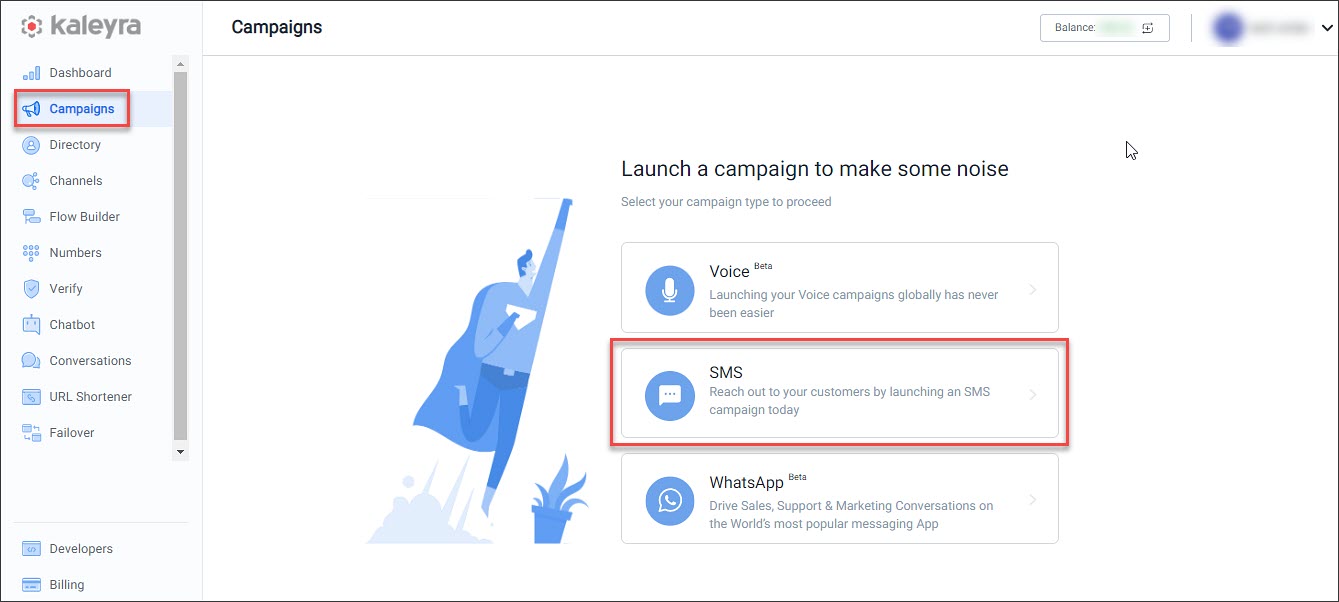
- On the Campaigns page, click Launch Campaign. The Launch Campaigns page appears.
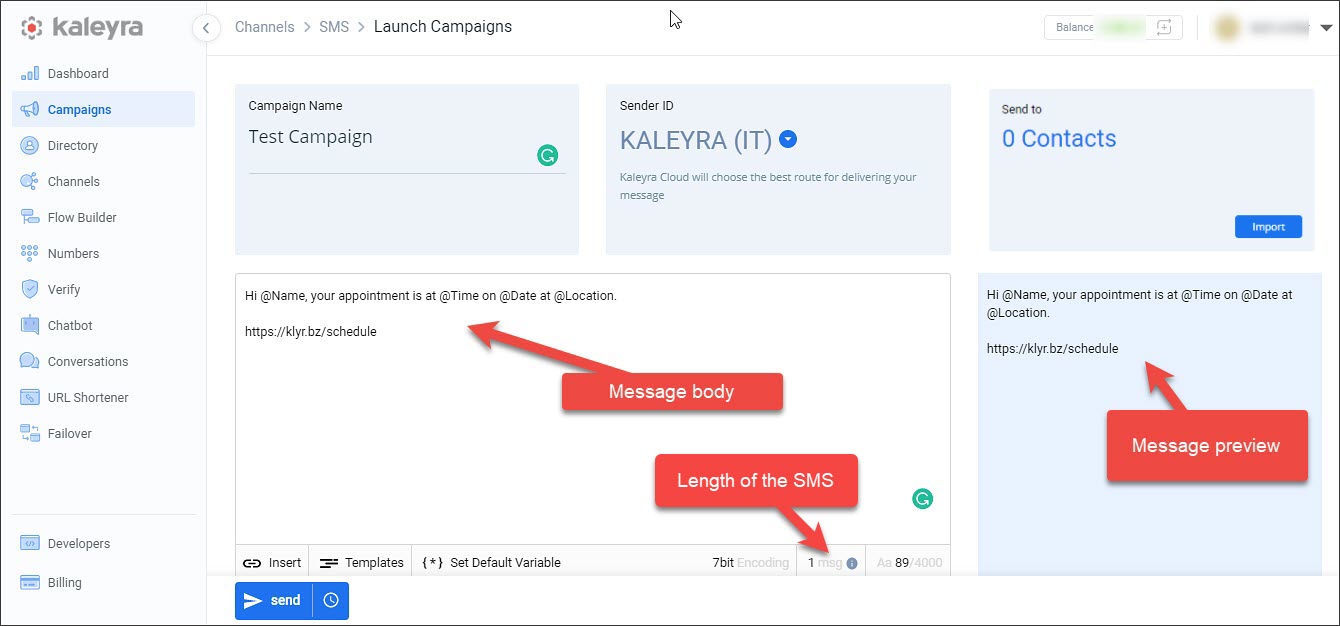
- In the Campaign Name field, enter the name of your Campaign.
- From the Sender ID dropdown list, select the sender ID from which the messages need to be sent. Ensure that you have at least one approved Sender ID, if not, refer to the Create a Sender ID page for more information.
- For IN region only, select the routes to send SMS. The options available are:
| Route | Description |
|---|---|
| Marketing | Marketing SMS is text messages to communicate offers, updates, and reminders to customers mainly used for marketing purposes. |
| Transactional | A transactional SMS is a non-marketing automated text message that companies send to support their audience along the customer journey. Among the most common transactional SMS types are order confirmations, welcome text messages, and shipping updates. |
| Transactional DND | You can deliver the Transactional DND messages to all recipients, irrespective of their Do-Not-Disturb (DND) status. Also, you can use these messages for sending order and booking alerts and informational messages to registered customers. |
| OTP | OTP SMS is one of the Smart Pin families and is a system to send to your mobile phone a "one-time password" for your all approval/verification for transaction/login/payment purposes. |
| M2M | Machine-to-machine communication (M2M) is two machines used for communicating or exchanging data without human interfacing or interaction. This includes serial connection, powerline connection (PLC), or wireless communications in the industrial Internet of Things (IoT). |
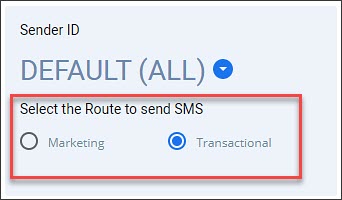
Note:
- For EU and SG regions, Kaleyra Cloud will choose the best route for delivering your message.
- Contact the Kaleyra Support team to have the required routes enabled for IN region.
- In the Send to the field, click Import more to import numbers to be used for the SMS campaign. You can import contacts by uploading a file, using the contacts in the Kaleyra Directory, or adding numbers manually. For more information, refer to the Import Contacts section.
- In the text field you can prepare the text of your SMS campaigns using one or more of the following actions:
- Enter text manually.
- Insert URL or Upload file. For more information, refer to the Insert Links or Upload a File section.
- Select text from a template. For more information, refer to the Add a Template section.
- Set Default Variable if your text has dynamic parts. For more information, refer to the Set a Default Variable section.
Note:
- The preview of the content added in this field is visible in the preview section.
- You can view the length of the SMS by clicking on
in the bottom of the text body section.
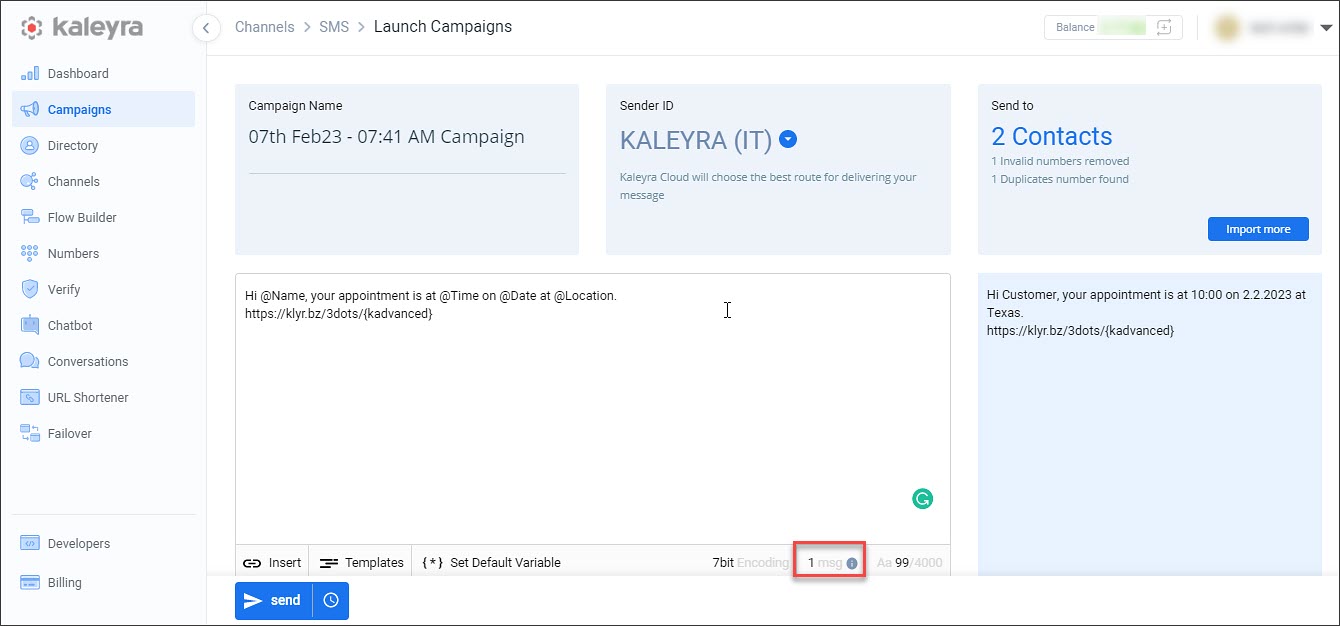
- Once the draft is ready, click Send to you can send the message immediately or click
 to schedule it for later. For more information, refer to the Schedule the Campaign section. The confirmation screen is displayed.
to schedule it for later. For more information, refer to the Schedule the Campaign section. The confirmation screen is displayed.

- Click Confirm to send/schedule the campaign.
All the campaigns you have created are listed on the Campaigns screen.
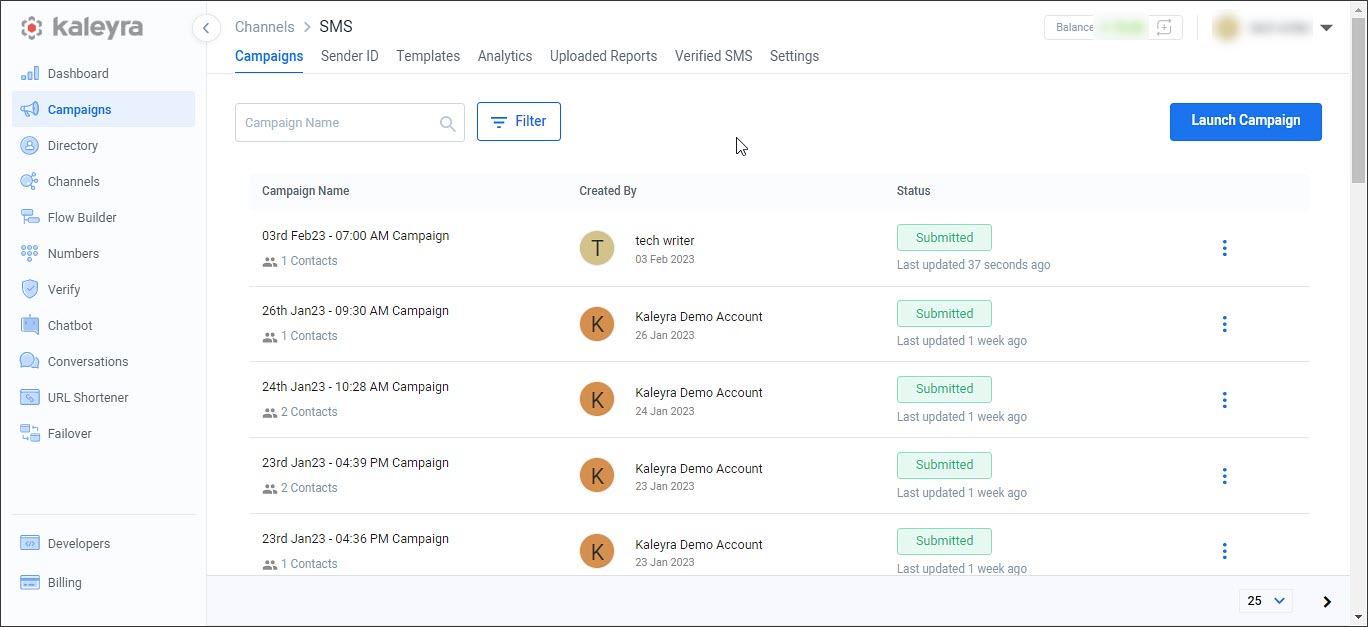
Import Contacts
You can import contacts into the campaign either by uploading a file, using the directory, or by copy and pasting.
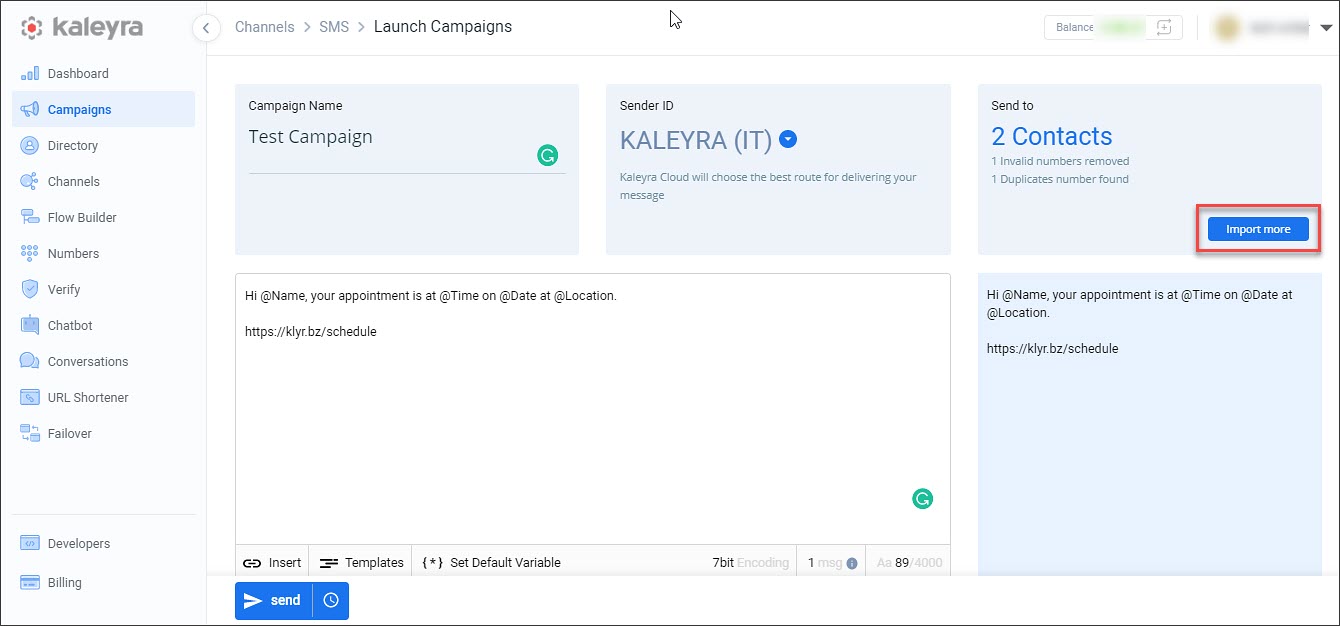
To import contacts on the Launch Campaign screen, click Import more. The Import Contacts page appears.

The Import Contacts page has the following options:
- File
- Directory
- Copy & Paste Numbers
You may use more than one option to import contacts for your campaign. For example, selecting the first contacts from the Directory, uploading one or more files, and then manually adding other numbers.
Note:You can view in the top left corner the number of contacts imported through Import Contacts for File, Directory, and Copy & Paste Numbers.
Import Contacts using the File option
To use the File option:
- Click File and then click Upload File to upload a file. You can upload either .CSV or Excel files.

A message "File Uploaded Successfully" appears. All the columns in the uploaded file will be listed in the Relevant Column from the uploaded file list.
- From the Relevant Column from the uploaded file list, map the relevant column from the uploaded file in the Mobile number drop-down list. If the uploaded file does not contain country codes, select the Doesn’t Include Country Code checkbox and select the applicable Country Code from the list.
Note:If the uploaded file contains country codes, and you select the Doesn’t Include Country Code checkbox, then all the numbers will be considered as invalid numbers.
- Click Import.
Note:Click Exclude if you want to exclude the numbers in the file from being used in the campaign.
Using Values in the Uploaded File as Dynamic Variables
All the column names in the uploaded file can be used as dynamic variables in the SMS text.
- Enter @ in the Message body field. All the columns in the upload file will be listed.
- Select the required column name.
Note:
- The data in the Mobile Number column will not be passed in the SMS to the user. However you will be able to see the mobile number in the Message preview section.
- The Message preview section will display the data based on the first row in the uploaded file.
- The data in the uploaded file gets precedence over the values defined for these fields using the {*} Set Default Variable option. For more information, refer to the Set a Default Variable section.
- The values defined using the {*} Set Default Variable option will only be applicable for the corresponding blank fields in the uploaded file.
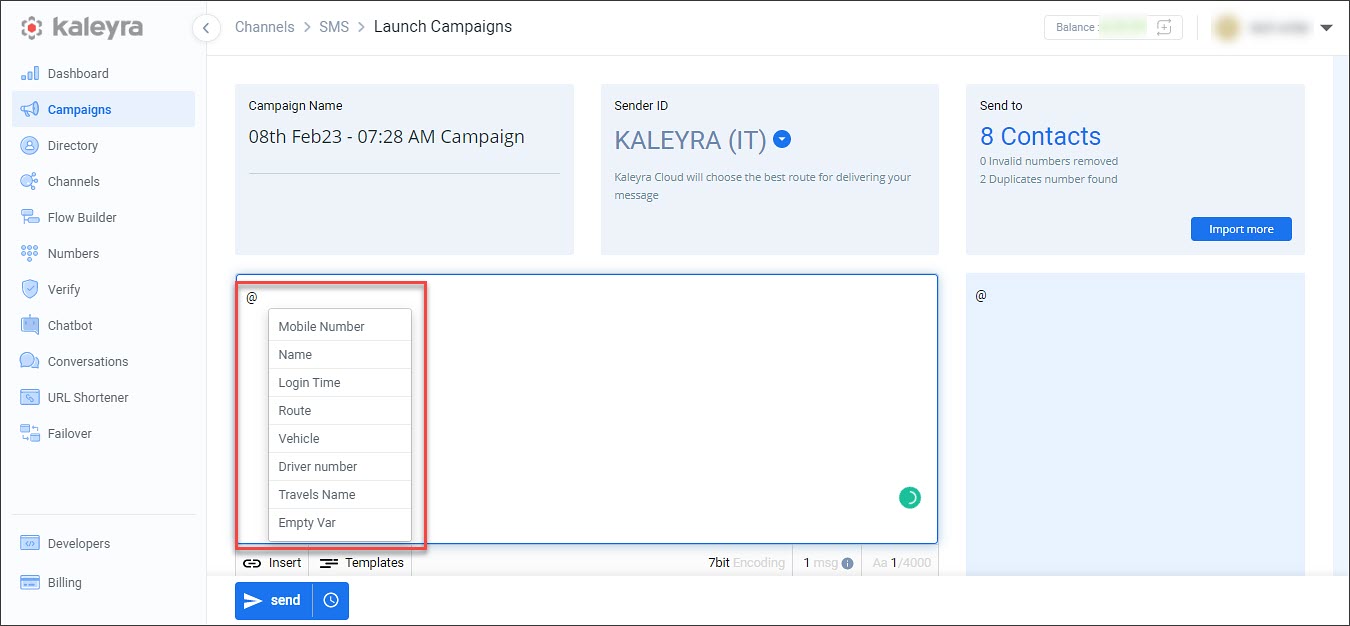
Support for URL Variable Replacement and Shortening
The support for the URL Variable Replacement feature allows you to attach the dynamic variables to the URL using .csv file.
The URL Shortening feature allows you to shorten the URL that will be displayed on the end-user's device. This action reduces the message's character count and estimated cost.
To support URL variable replacement and shortening, perform the following steps:
- On the Launch Campaigns page, copy and paste the URL in the message body. OR select a template that already includes the URL with variables defined. If necessary, you can attach the variables to the URL using @ or {}. For example, https://www.google.com/@dynamic/{variable}.
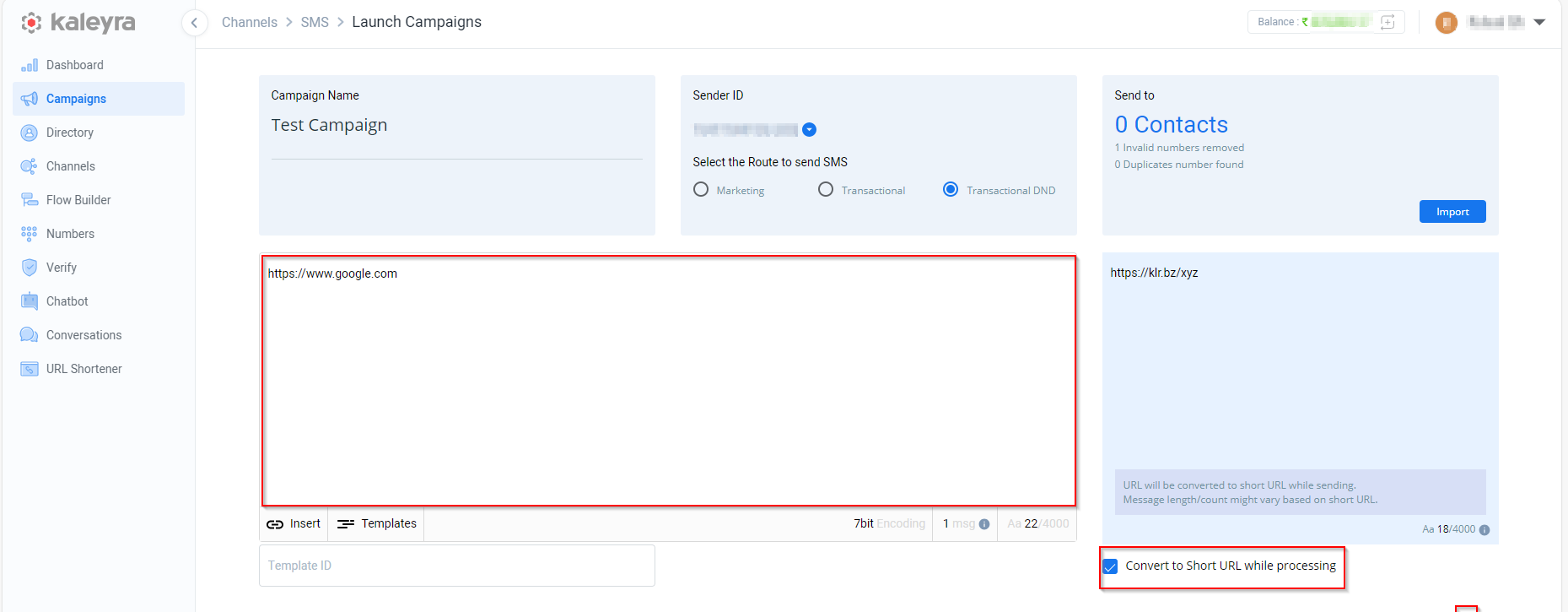
- The Convert to short URL while processing checkbox is available or enabled only if the platform identifies a valid URL in the message body. You can view a tooltip displayed "URL will be converted to short URL while sending. Message length/count might vary based on short URL" on the message preview box.

Note:Upload a .CSV file with data values in columns that will replace variables in a URL.
- You can view the revised character count of the shortened URL length by clicking on the gear icon available at the right corner on the message preview box.
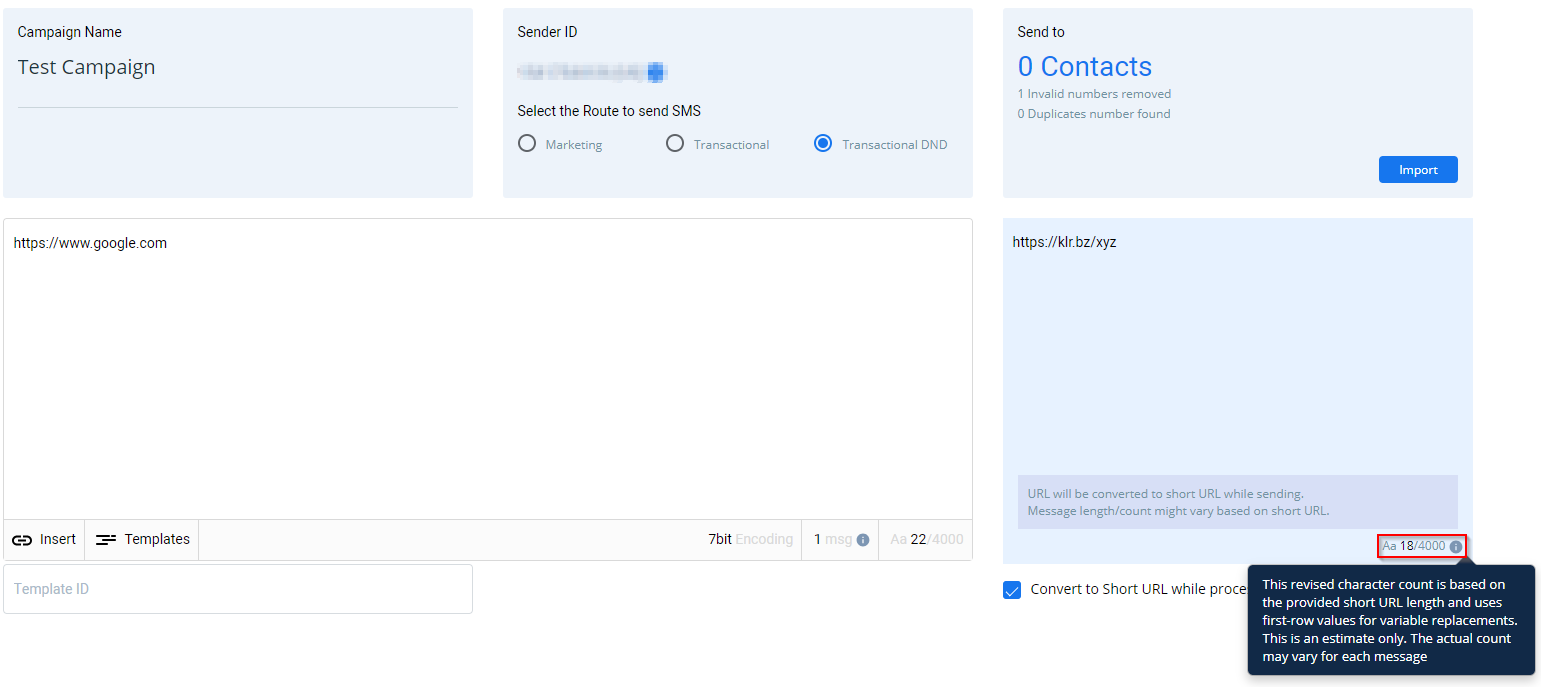
Import Contacts using the Directory option
To use the Directory option, click Directory, select the required numbers, and click Import Contacts. For more information regarding Kaleyra Directory, refer to https://developers.kaleyra.io/docs/directory-overview.
Note:You can use the Filter option to search for a specific number by Name, City, Country, and Tags.
Select the numbers in the Directory and click Exclude if you want to exclude the numbers from being used in the campaign.
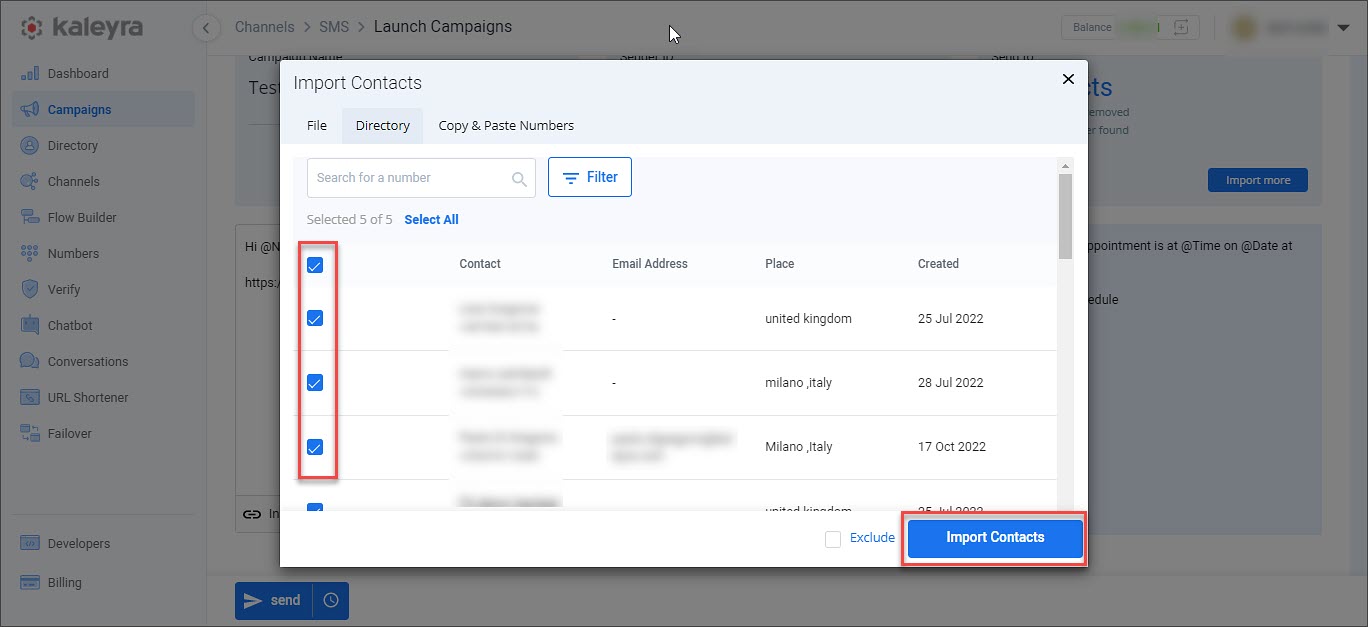
Import Contacts using the Copy & Paste Numbers option
To use the Copy & Paste Numbers option, click Copy & Paste Numbers. Enter or paste the numbers in the text box and click Import.
Note:If you have not entered the country code, select the Doesn’t Include Country Code checkbox and select the applicable Country Code from the list.
Enter the numbers in the text box and click Exclude if you want to exclude the numbers from being used in the campaign.
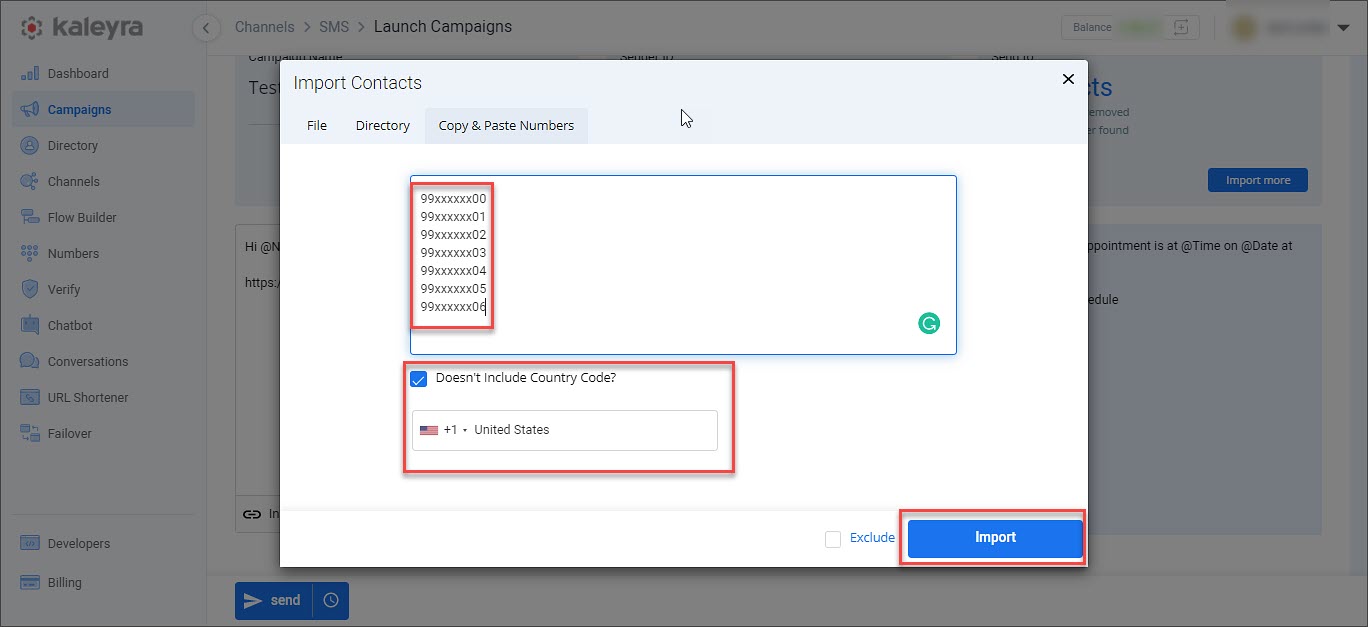
Note:The phone number list is validated to identify duplicate as well as invalid numbers.
Insert Link or Upload a File
The Insert Link feature allows you to shorten a URL or to create a URL to share a file through SMS.
- On the Launch Campaigns page, click Insert.

The Insert Link page appears.
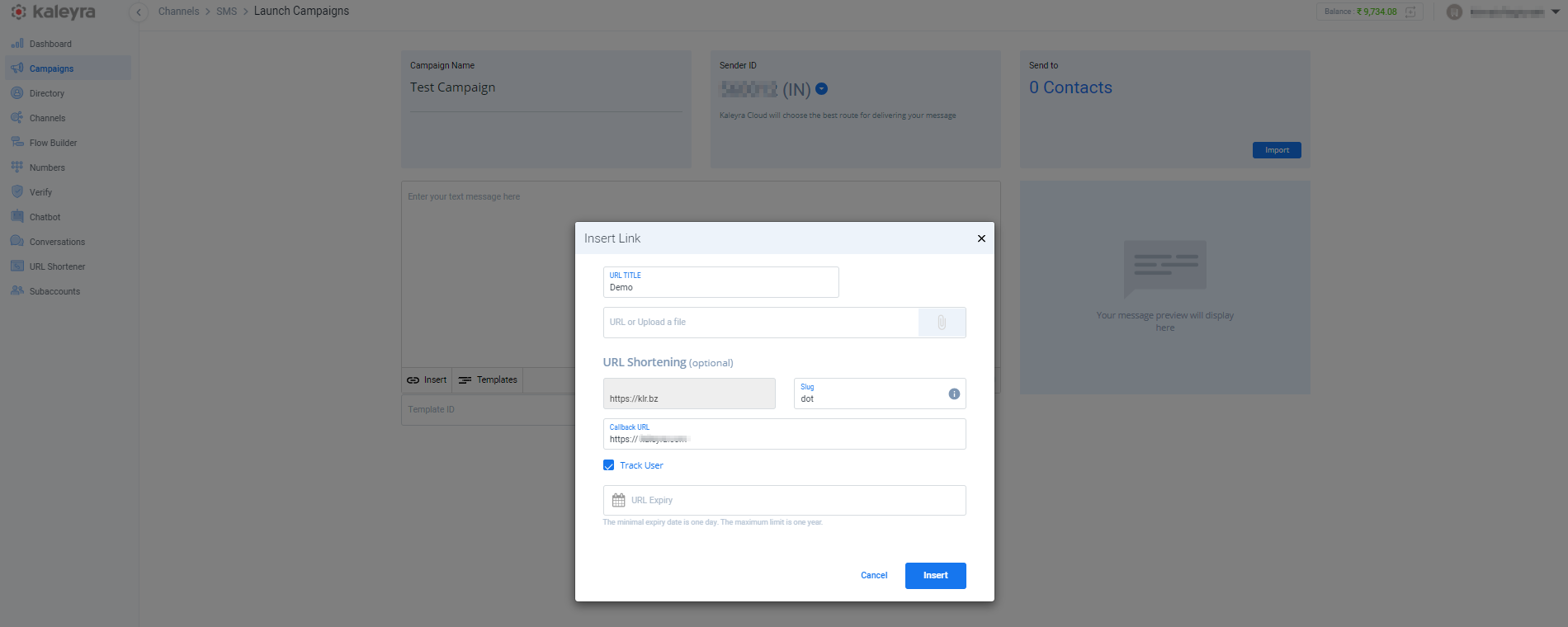
- In the URL TITLE field, enter the URL title.
Note:The maximum character limit for URL title is 100 characters.
- In the URL or Upload a file field, either enter the URL or click
 and upload the required file.
and upload the required file.
The URL or Upload a file field has a dual purpose:
- You can insert a URL link (by typing or copy/paste text) then kaleyra.io will generate a shortened URL.
- You can upload a file to be inserted in the message as a link; kaleyra.io will store the file and will generate a shortened URL to access it.
Note:The maximum image file size is 100MB and the supported file formats are pdf, png, and jpg.
- The URL Shortening section has the following fields:
i. In the Slug field, enter the slug to be displayed for the customer. It may contain letters, numbers, and dashes with a maximum of 10 characters. A Slug is the unique identifying part of a web address, typically at the end of the URL. For example, in the URL "http://www.carsforsales.com/vans-camper"
In this case, 'vans-camper' is the URL slug.
ii. In the Callback URL field, enter the callback URL where you wish to receive updates about clicks on the Shortened URL along with related information including a timestamp.
iii. Select the Track User checkbox. This will let you know exactly which contact you have clicked on the Shortened URL. If the track user is not selected, only the overall number of clicks on the URL and the overall number of unique clicks on the Shortened URL will be provided as analytics but, you will not know which recipients clicked and which not.
iv. In the URL Expiry field, select the expiration date for the shortened URL, any click on the shortened URL after the expiration date will not make the end-user land on the actual page defined by the long URL. The URL Expiry field should be on a future date. The date format supported is DD/MM/YYYY.
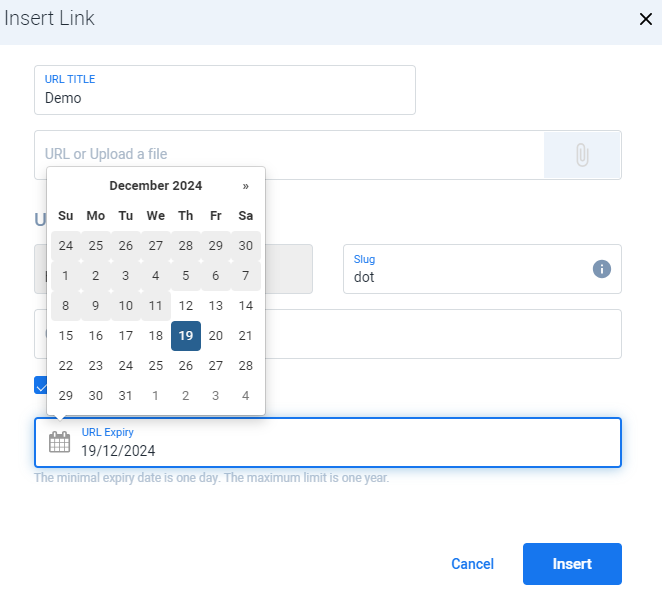
Note:
- The minimum expiry limit is one day, while the maximum expiry limit is one year.
- If expiry date is not selected, then the shortened URL will default to an expiry of 6 months.
v. Click Insert. The URL Shortened Successfully message appears.

Add a Template
- On the Launch Campaign page, click Templates to view the existing message templates.

The Insert Template page is displayed.
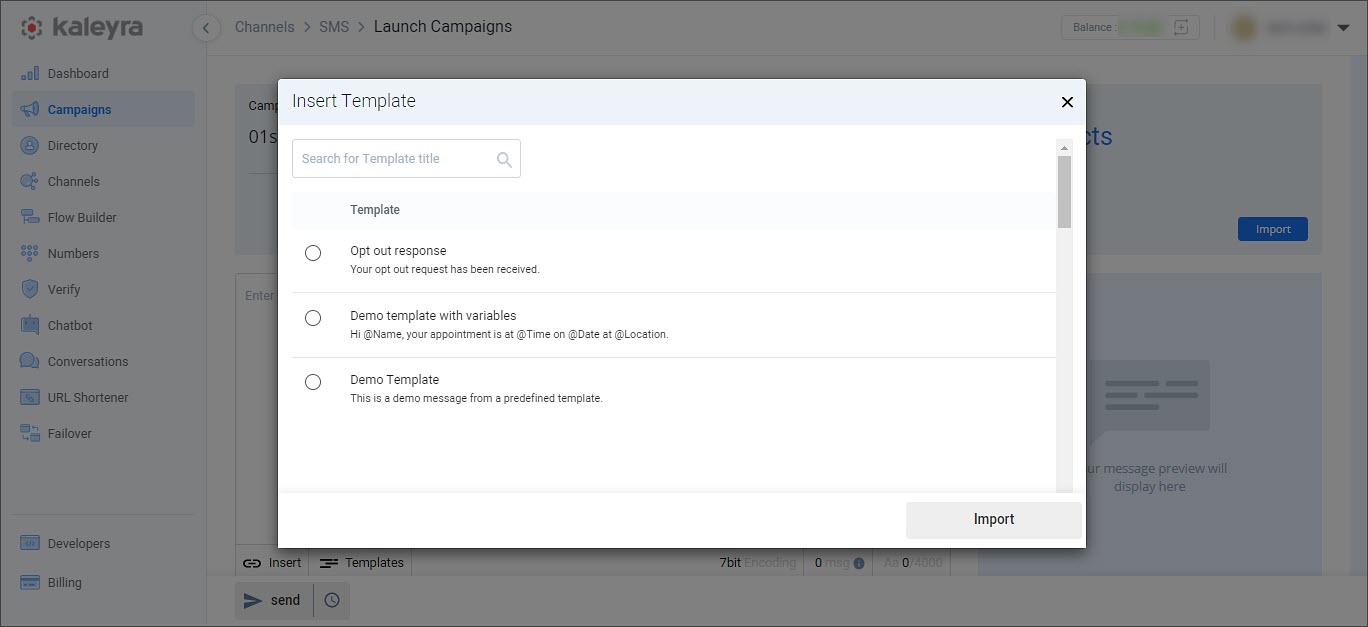
- Choose the desired template and click Import.
Note:For more information on how to create an SMS template, refer to https://developers.kaleyra.io/docs/create-template
Set a Default Variable
You can set default values for the variables in your SMS Campaigns. The default values will be used in the message when the contact does not have a value for the variable defined in its record.
You will see an option to {*} Set Default Value in the text editor ONLY when the message body includes at least one dynamic variable. Variables identified using the @ or {} symbol will be eligible to set default values.
To set default values, perform the following steps:
- On the Launch Campaigns page, if your message body contains at least one dynamic variable, click {*} Set Default Value.
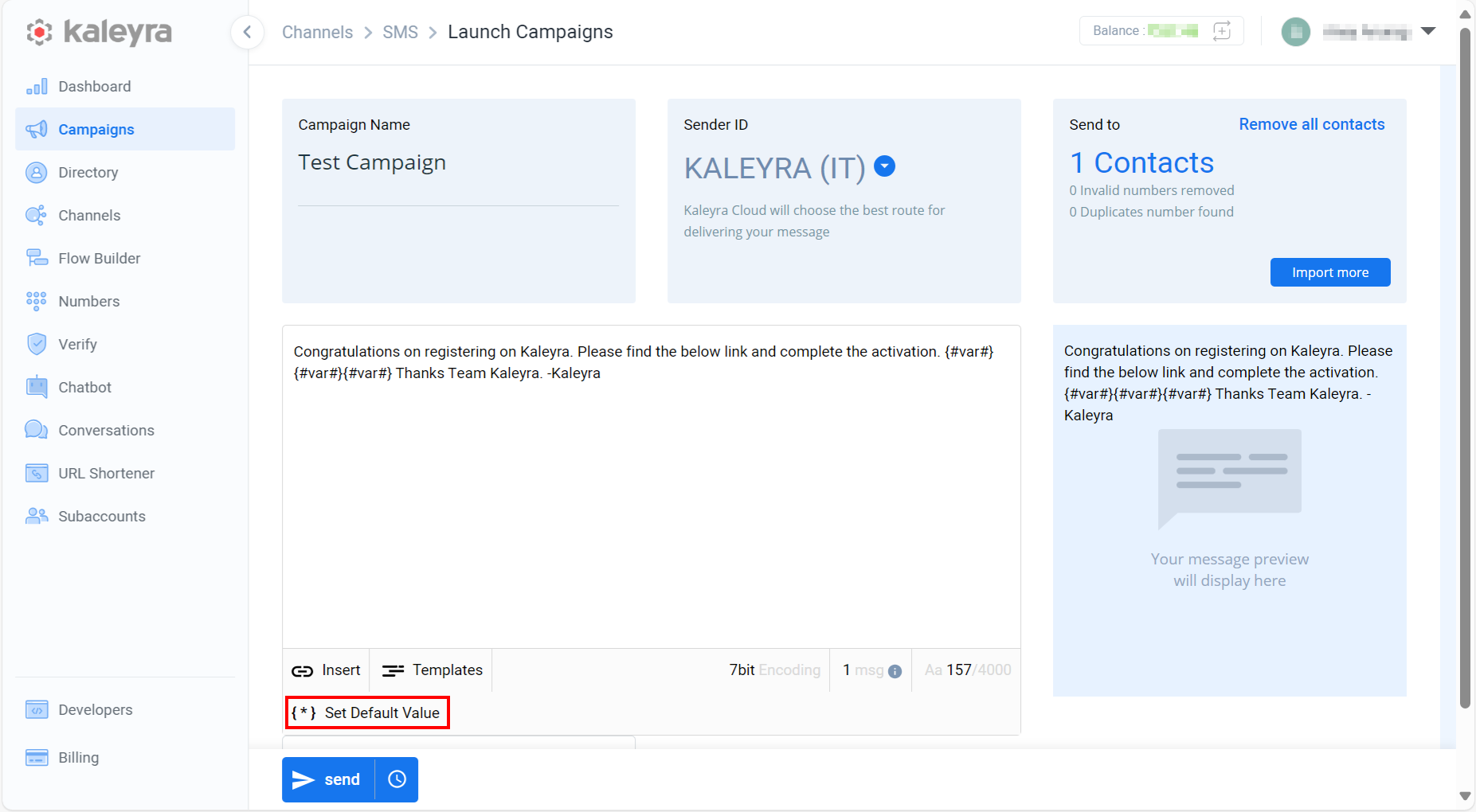
The Set Default Value page appears listing all the dynamic variables (parameters) used in the message body.
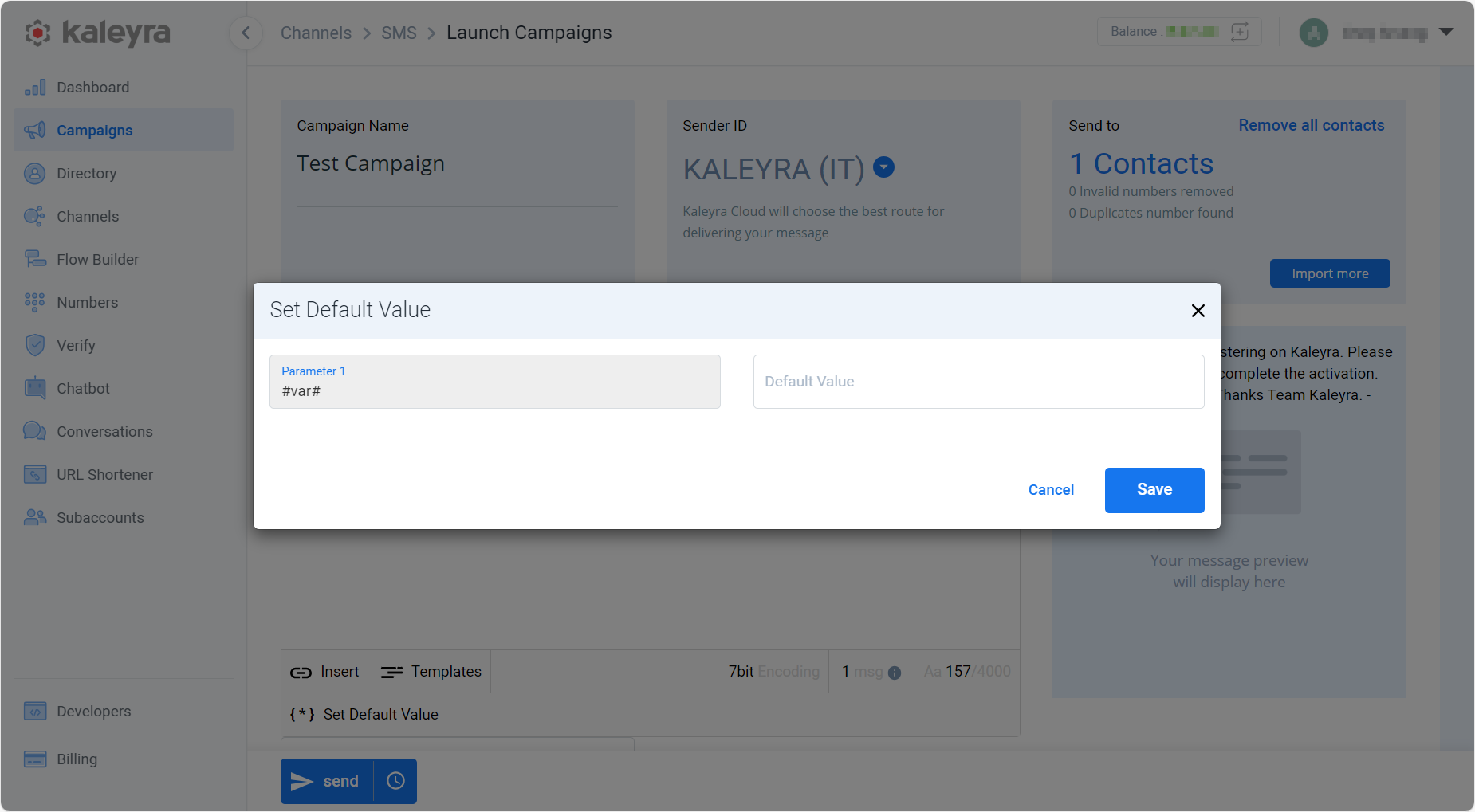
- In the Default Value field, enter the required default values to the listed parameters. The default value will be picked up in case, for a given recipient, no value to substitute the dynamic variable is found in the uploaded campaign file; this will avoid sending SMS with actual text displaying dynamic variable instead of a proper value.
- Click Save.
Schedule the Campaign
You can schedule the campaign to run at a designated time in the future. To schedule a campaign:
- On the Launch Campaign page, click
 .
.
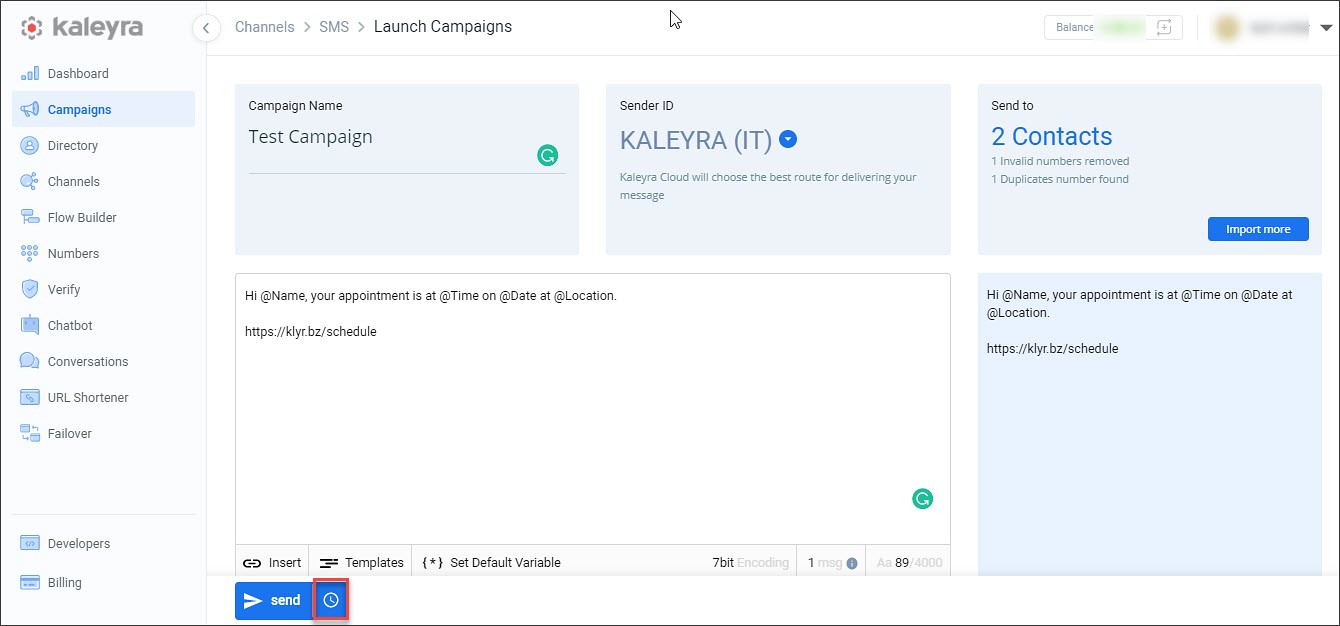
The Schedule Campaign screen appears.

- From the Timezone list, select the required timezone.
- In the Date field, select the date using the calendar.
- In the Time file, select the time.
- If you have more than one thousand contacts and you want to split the campaign schedule, select the Split Campaign Schedule checkbox.
- In the Contacts per Batch field, enter the number of contacts.
Note:The minimum number of contacts per schedule is one thousand.
- From the Time Interval dropdown, select the required time interval for the split schedule.
- Click Schedule Send.
Campaigns listing page
To view the list of SMS Campaign:
- Sign in to your kaleyra.io account.
- Go to Campaigns and then click SMS. The Campaigns page appears with a list of all the Campaigns with the following information:
| Column | Description |
|---|---|
| Campaign Name | The name of the campaign, along with the number of contacts that the Campaign is sent to. |
| Created By | Sender’s name and time stamp. |
| Status | The status of the campaign along with the ‘last updated’ information. This column has a tooltip icon, when hovered over it displays more information about the campaign status. |
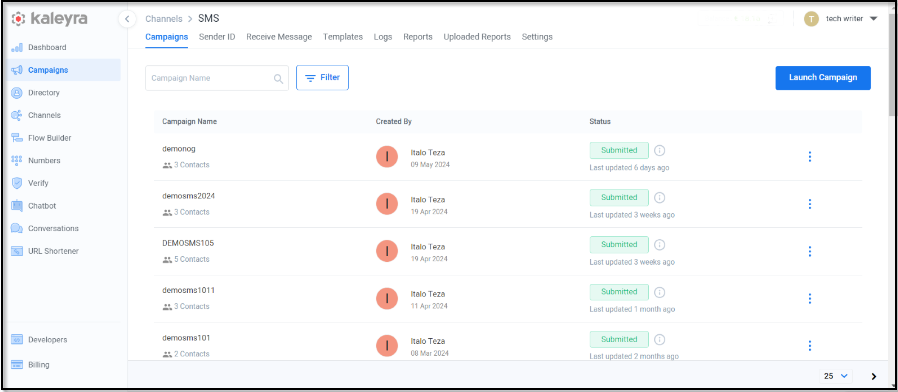
The following table contains the SMS Campaign Delivery Status and the corresponding tooltips:
| Status | Tooltip |
|---|---|
| Submitted | Messages have been submitted to carriers/operators. |
| Scheduled | The Campaign is scheduled to send messages at a later date or time. |
| Draft | The Campaign has not been submitted or scheduled yet. |
| Failed | Messages were unable to be submitted to carriers/operators (either partially or completely). |
| In Process | Messages are currently being sent to carriers/operators. |
| Completed | Messages have been submitted to carriers/operators. |
| Cancelled | The Campaign was cancelled. |
| Deleted | The Campaign was deleted. |
Updated 6 months ago
